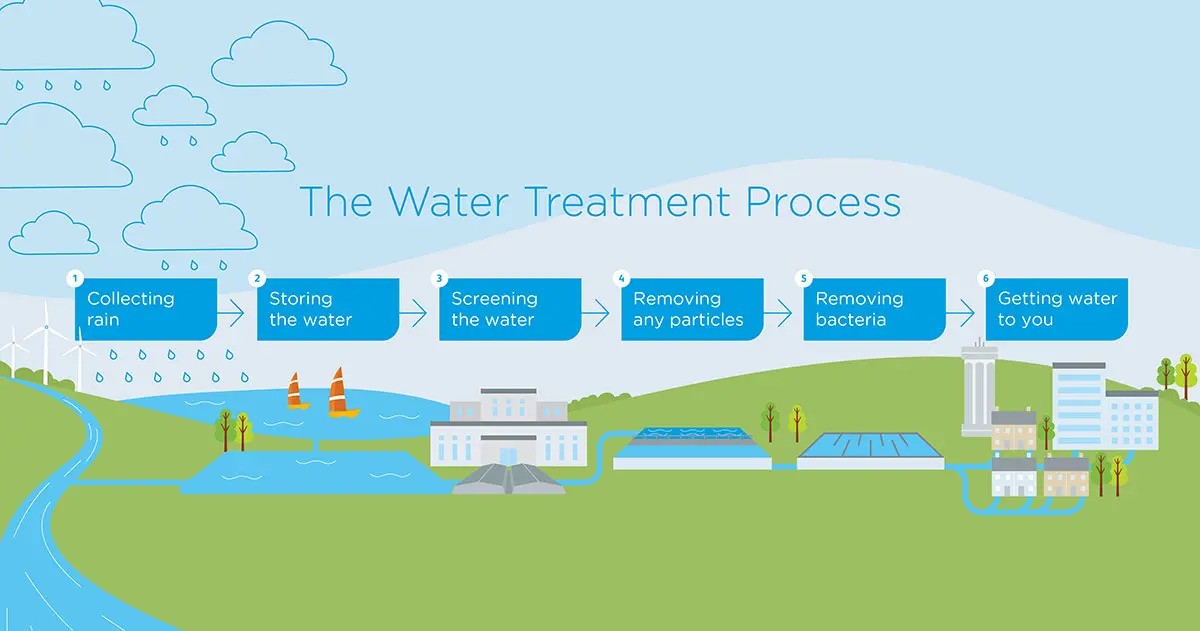The water treatment process
Do you ever wonder how the rain that falls from the sky ends up in your taps, or how we treat it and then get it to you?
Well, between it falling from the sky and coming out of your taps, there's a whole process that involves hundreds of treatment sites, Thames Water employees, 20,000 miles of pipes and half a million tests. We work 24 hours a day to make sure that we provide you with the best-quality water.

1. Collecting rain
The water that comes out of the taps at your home, school and work starts off as rain.
This rainwater either flows into rivers and streams or filters through the earth to form ‘groundwater’.
We then pump this water to our water treatment works where it goes through various treatment processes before we send it to you.
As we take water from various rivers and ground water sources, the quality of it can be different, so the treatment process it goes through is tailored to make sure we give you the best-quality water possible.
Did you know?
We are only allowed to pump a certain amount of water out of rivers and underground sources so that we don’t harm the environment. That's why we must all use it wisely.
2. Storage
At some of our larger water treatment sites, we store the water in reservoirs before it goes through the treatment process.
We store the water in reservoirs for two reasons:
- So that we have a store or reserve of water, so if it hasn’t rained for a while or we can’t pump as much water from the rivers or groundwater sources, we have water available to put through the treatment process. Some of our reservoirs have enough water to last parts of the region for 90 days.
- Storing the water in reservoirs starts the natural clean-up process, as heavier particles settle to the bottom, meaning we don’t have to take them out.
Did you know?
We have 30 reservoirs, some of which are used by local communities for sailing, fishing, nature walks and bird watching.
3. Screening
Once we've collected the water, we put it through a screen to capture any branches or leaves. If left in the water they'd almost certainly clog up the treatment process.
4. Removing particles
Flocculation
At some of our treatment sites we add a solution to the water to make the particles bigger and easier to remove. This is called flocculation.
Filtering
To make sure we produce the purest water possible for customers, the water is then put through two more filters to remove the invisible particles:
- Rapid gravity filters
The water is passed through a tank full of coarse sand. The sand traps particles as the water passes through. - Slow sand filters
The water is then slowly filtered through large beds of much finer sand. This removes any remaining fine particles before the water goes for final treatment.
At some water treatment works we also use extra methods to remove invisible and dissolved particles from the water, such as ozone, carbon and ion exchange. These methods create chemical reactions in the water and remove fine particles.
5. Final treatment
Once the water has been treated, the last thing we do is add a very small amount (less than one milligram per litre) of chlorine to it. This kills any remaining organisms or bacteria and keeps the water safe, right up until it reaches your tap.
Did you know?
We test the water at every stage of the treatment process. In fact, we carry out more than half a million tests a year on our water, which our team of samplers and scientists analyse in our laboratories.
6. Getting water to you
Following final treatment, the water leaves the treatment works and is stored in covered reservoirs.
It's then pumped to you through our network of pipes and pumping stations.
Did you know?
The quality of our water is among the best in the world and it constantly beats bottled water varieties for taste.